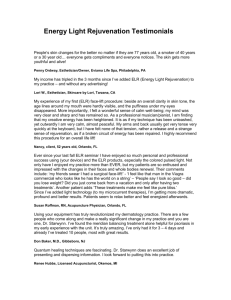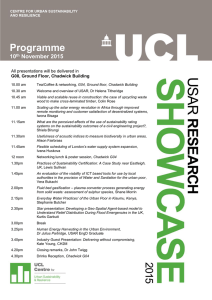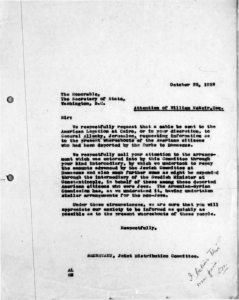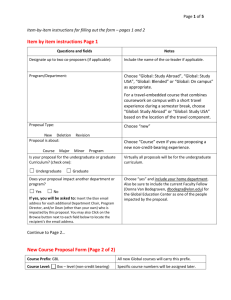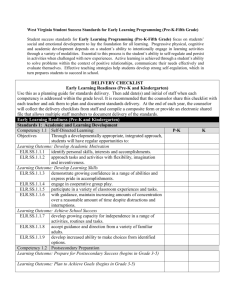Document 13617555
advertisement
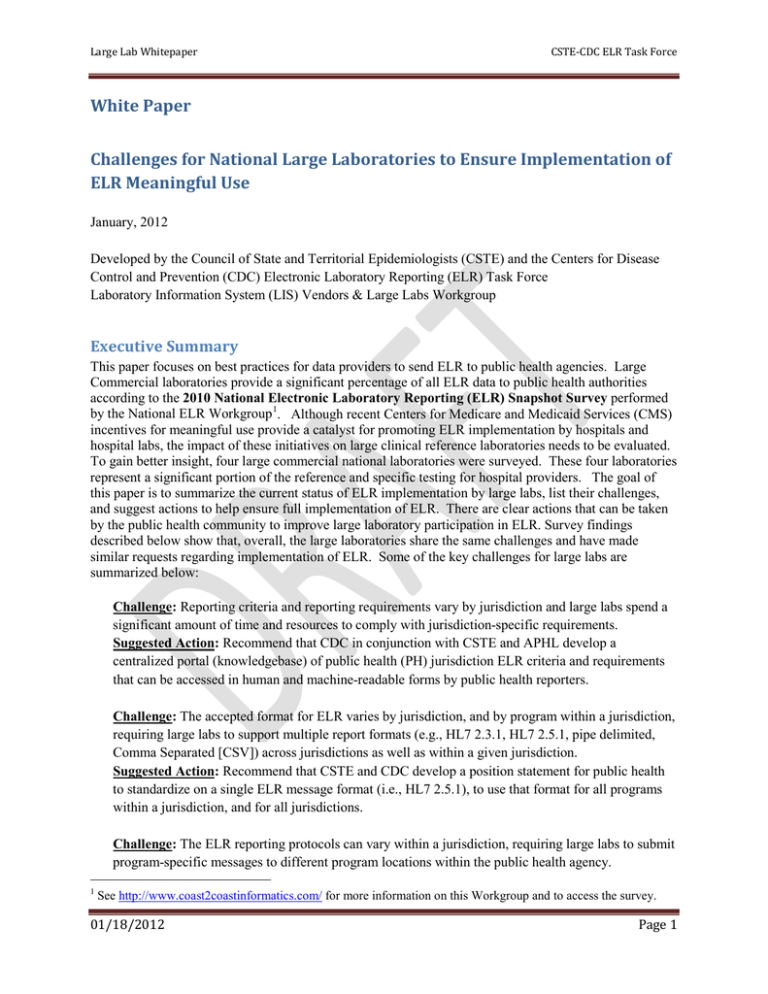
Large Lab Whitepaper CSTE-CDC ELR Task Force White Paper Challenges for National Large Laboratories to Ensure Implementation of ELR Meaningful Use January, 2012 Developed by the Council of State and Territorial Epidemiologists (CSTE) and the Centers for Disease Control and Prevention (CDC) Electronic Laboratory Reporting (ELR) Task Force Laboratory Information System (LIS) Vendors & Large Labs Workgroup Executive Summary This paper focuses on best practices for data providers to send ELR to public health agencies. Large Commercial laboratories provide a significant percentage of all ELR data to public health authorities according to the 2010 National Electronic Laboratory Reporting (ELR) Snapshot Survey performed by the National ELR Workgroup 1. Although recent Centers for Medicare and Medicaid Services (CMS) incentives for meaningful use provide a catalyst for promoting ELR implementation by hospitals and hospital labs, the impact of these initiatives on large clinical reference laboratories needs to be evaluated. To gain better insight, four large commercial national laboratories were surveyed. These four laboratories represent a significant portion of the reference and specific testing for hospital providers. The goal of this paper is to summarize the current status of ELR implementation by large labs, list their challenges, and suggest actions to help ensure full implementation of ELR. There are clear actions that can be taken by the public health community to improve large laboratory participation in ELR. Survey findings described below show that, overall, the large laboratories share the same challenges and have made similar requests regarding implementation of ELR. Some of the key challenges for large labs are summarized below: Challenge: Reporting criteria and reporting requirements vary by jurisdiction and large labs spend a significant amount of time and resources to comply with jurisdiction-specific requirements. Suggested Action: Recommend that CDC in conjunction with CSTE and APHL develop a centralized portal (knowledgebase) of public health (PH) jurisdiction ELR criteria and requirements that can be accessed in human and machine-readable forms by public health reporters. Challenge: The accepted format for ELR varies by jurisdiction, and by program within a jurisdiction, requiring large labs to support multiple report formats (e.g., HL7 2.3.1, HL7 2.5.1, pipe delimited, Comma Separated [CSV]) across jurisdictions as well as within a given jurisdiction. Suggested Action: Recommend that CSTE and CDC develop a position statement for public health to standardize on a single ELR message format (i.e., HL7 2.5.1), to use that format for all programs within a jurisdiction, and for all jurisdictions. Challenge: The ELR reporting protocols can vary within a jurisdiction, requiring large labs to submit program-specific messages to different program locations within the public health agency. 1 See http://www.coast2coastinformatics.com/ for more information on this Workgroup and to access the survey. 01/18/2012 Page 1 Large Lab Whitepaper CSTE-CDC ELR Task Force Suggested Action: Recommend that CSTE and CDC develop a position statement for each public health jurisdiction to support the receipt of ELR at a single location within their jurisdiction. Challenge: Considerable resources and time are spent by large labs to educate their clients on reportable conditions and appropriate tests codes to use when ordering tests (e.g., requesting use of “Hepatitis B Ag” instead of “Hepatitis B”). Suggested Action: Recommend that public health (CSTE, APHL and CDC) educate hospital providers on mapping local codes to standard codes, identifying reportable conditions, and constructing messages that meet the needs of public health. Challenge: There is no incentive for large labs to implement ELR under Stage I of Meaningful Use and their clients are not requesting that they provide HL7 2.5.1 messages. Suggested Action: Recommend that CMS or Office of the National Coordinator (ONC) for Health Information Technology provide an incentive to encourage large labs to move to HL7 2.5.1 and comply with meaningful use requirements for the reportable laboratory results public health objective. Background In July 2010, CMS published the final rule that implements the provisions of the American Recovery and Reinvestment Act of 2009 (ARRA) and the resultant Health Information Technology for Economic & Clinical Health (HITECH) act. This regulation provides incentive payments to Eligible Professionals (EPs), Eligible Hospitals (EHs) and Critical Access Hospitals (CAHs) participating in Medicare and Medicaid programs that adopt and successfully demonstrate meaningful use of certified electronic health record (EHR) technology. Also, ONC has issued a closely related regulation that specifies the adoption of an initial set of standard implementation specifications for electronic health records; these specifications form the basis for certification criteria for Health Information Technology (HIT). Certified EHR technology used in a meaningful way is one piece of a broader HIT infrastructure needed to reform the health care system and improve health care quality, efficiency, and patient safety – this concept has been commonly called “Meaningful Use” (MU). There are three public health objectives in Meaningful Use Stage 1, namely the capability to submit electronic data to public health in the context of 1) Immunizations, 2) Reportable Laboratory Results (Eligible Hospitals [EH] only) and 3) Syndromic Surveillance. In order to meet Stage 1 Meaningful Use criteria, EHs must choose one of these three public health objectives. A CSTE & CDC ELR Task Force was formed with the following vision: All labs (public and private) conducting clinical testing identify laboratory results that indicate a potential reportable condition for one of the jurisdictions they serve, format the information in a standard manner, and transmit appropriate messages to the responsible jurisdiction; all jurisdictions can and do receive and utilize the data. CDC is collaborating with the CSTE and the Association of Public Health Laboratories (APHL) on the CSTE/CDC ELR Task Force and have formed five ELR Task Force workgroups. One of these workgroups, LIS vendors & Large Labs Workgroup is charged to assist and advise laboratories and the 01/18/2012 Page 2 Large Lab Whitepaper CSTE-CDC ELR Task Force vendors who supply laboratory information system software with the implementation of electronic laboratory reporting under the CMS incentives for meaningful use 2. This same work group also recognizes the importance of the large commercial laboratory sector to fully implement ELR meaningful use and their role for sending laboratory results to jurisdictional public health departments. Introduction This paper focuses on the large national commercial laboratory sector that provides significant testing reportable through ELR. Large laboratories already report ELR data to hospital providers and to state public health programs. Building upon these relationships is important to ensure full implementation of ELR. For this effort four of the larger national laboratories were surveyed. These four laboratories represent a significant portion of the reference, esoteric, and offsite testing for hospital and outpatient providers. The goal of the survey was to provide a listing of challenges faced by large labs in implementing ELR. The results of laboratory interviews are included in Table 1, below. This table summarizes the findings from the interviews with each lab. The statements under each question in the table represent the responses made by the labs during the interview. The table provides a visualization of issues or challenges that were common across the labs. The individual survey results are de-identified; each laboratory is assigned a Letter A, B, C, or D. The responses were coded as “x” for a positive response and “n” for a negative response. A blank indicates no response was entered for that option. Table 1 - Summary of Large Lab Responses Large Laboratory Responses 1. Lab A Lab B Lab C Lab D Biggest challenges you face in using ELR for reporting to public health jurisdictions? a. Varied notifiable disease reporting requirements exist across public health jurisdictions (state & local) b. Varied electronic messaging and vocabulary formats c. Resources required to modify reporting systems to meet changing lab reporting requirements d. Utilize "home grown" application components to report from the large lab’s LIS to ELR which can be costly to manage and update e. Tracking the different state reporting formats and ELR requirements is costly and requires a dedicated FTE f. PH jurisdiction ELR requirements are not consistent between states and are often buried in their websites x x x x x x x x x x x x x x x x x x x x x x x g. Consistently see an increase in the need for state resources for ELR x x x 2 CDC defines Electronic Laboratory Reporting (ELR) as the electronic transmission from laboratories to public health of laboratory reports which identify reportable conditions. ELR has many benefits, including improved timeliness, reduction of manual data entry errors, and reports that are more complete. 01/18/2012 Page 3 Large Lab Whitepaper CSTE-CDC ELR Task Force h. Reports are sent using spreadsheets based on PH requirements i. A central place at a jurisdiction to report data would be very helpful j. No “turnkey” approach to communicate ELR to PH x x x x x x x x x x k. Patient demographics are not included in the lab orders x x x l. Due to LIS limitations, microbiology (e.g., culture, antimicrobial resistance) tests are faxed x x x x x m. Systems built for cancer & pathology reporting are different from general communicable diseases reporting systems at the large labs x x n. Need for improved IT capability at the PH end x x o. The need for standardization in the electronic message is beyond the laboratory data, significant variability exists within the content of the message( e.g., address street number or zip code formatting) Reasons many public health jurisdictions have not utilized ELR for receipt of your reports 2. x x x a. Lack of information technology expertise at PH jurisdiction x b. A lack of information/resources for PH staff to utilize ELR x that is reported (e.g., codes and code system mappings for lab tests) x x x c. PH should educate ELR reporters on ELR requirements to ensure quality data is reported x d. Resolve ambiguities regarding reporting responsibilities (e.g., if a lab sends the specimen to a lab belonging to a different company then are qualifying results sent directly to the jurisdiction’s health department or sent back to the originating lab who will send them to the jurisdiction’s health department?) Response to the recent HHS ONC recommendations to use HL7 2.5.1 for achieving 3. “Meaningful Use” criteria 3? a. Large lab uses HL7 2.5.1 x x b. Large lab uses HL7 2.3.1 or HL7 2.3.z x c. Without incentives electronic data management/messaging x using HL7 2.5.1 is not a high priority x x d. PH jurisdictions are not requesting HL7 2.5.1 e. Would like to grandfather existing large lab interfaces and ELR implementations instead of developing new interfaces to support meaningful use in HL7 2.5.1 f. Would be in favor of HL7 2.5.1 migration if a single message were used by all jurisdictions with no jurisdictionspecific modifications of the standard Coding systems Used for ELR messaging to public health jurisdictions? 4. 3 x x x x x x x x x x x x x http://edocket.access.gpo.gov/2010/pdf/2010-17207.pdf 01/18/2012 Page 4 Large Lab Whitepaper CSTE-CDC ELR Task Force x x x x a. Large lab uses Logical Observation Identifiers Names and Codes (LOINC®) x x x b. Large lab uses Systematized Nomenclature for Medicine (SNOMED) x c. Large lab uses Current Procedural Terminology (CPT) x d. Large lab uses International Classification of Diseases version 9 (ICD-9) x x e. Unified Code for Units of Measure is an example of a requirement in MU specifications that may shift code strings and formats in electronic deliverables. Large labs would like to see requirements piloted between vendors and laboratories before adoption x x x x f. Would like to see PH jurisdictions harmonize use of test codes and result codes. Familiarity with “Reportable Condition Mapping Tables” (RCMT) 5. x a. Has experience with RCMT x x x x b. Believe that a central store with reporting criteria and requirements for all jurisdictions would facilitate reporting x x x x c. Reportable conditions should be linked to LOINC®, however this first requires mapping local codes to LOINC®- this process is semi-automated x x x x d. Would like more opportunities to learn of national reporting requirements x x x x e. Multiple LOINC® codes for the same test should be standardized in the RCMT where possible. x x x f. LOINC® codes are not always used by clients, instead pre- x set panels of tests are used. Large Laboratories response to ELR “Meaningful Use” (MU) of electronic health record 6. systems x x x x a. Large labs are not paying significant attention to MU x x x b. Pressure to participate must come from client needs and the x market or regulations How CDC or HHS can best facilitate increased ELR adoption and reporting. 7. x a. Grant money b. Non-monetary incentives like tools to facilitate ELR to PH x x x x c. Develop business case that will justify change to the large lab’s IT systems x x d. Collaborate with stakeholders including CDC or HHS x x e. Share viewpoints of diverse laboratories-large and small Benefits and challenges of having a secure internet-based reporting site for ELR results (e.g., 8. cloud-based infrastructure to simplify lab reporting and public health retrieval) x x x x a. A "cloud" or secure hub with a standard message structure x x x b. Need for jurisdiction buy-in to a new technical solution (e.g., cloud based infrastructure) c. Must overcome fear of centralized location, security, and 01/18/2012 x x Page 5 Large Lab Whitepaper CSTE-CDC ELR Task Force privacy concerns (e.g., HIV security requirements) Questions to public health officials in relation to ELR implementation process, standards or 9. policy x x x a. The more standardized message formats are, the simpler to x manage ELR, so what is PH’s reservation towards streamlining the requirements? b. What is the future of PHIN MS and PH roadmap for NHIN x Direct? x x x c. PH has an important role to work with providers to standardize and streamline the data feed sent to labs, so that labs can subsequently comply with PH reporting needs for ELR Current Status Large labs are responsible for reporting to multiple public health jurisdictions based on the reporting requirements/criteria at the local and state level. They need to know the rules governing reporting and when those rules change. Large lab reporting would be simplified if public heath reduced the variability in reporting requirements that currently exists. Large labs would also benefit from a centralized portal for jurisdictional reporting requirements that includes information about how to report, to whom a particular type of report should be sent, what should be included in the report, and the format that is expected. The large lab survey showed consensus across lab organizations in the areas below: • Incentives for large labs come from two places: the marketplace and from laws/regulations at the local or state PH jurisdiction level. Current CMS incentives do not include large labs. • Significant time and resources are required to meet varying PH jurisdiction requirements. If PH jurisdictions passed a regulatory requirement for HL7 2.5.1 data transmission then large labs may comply. • Completeness of HL7 ELR message continues to be a challenge. Large labs cannot provide a complete HL7 record to PH because Health care providers are under no mandate to send demographic data to large labs. • Hospital providers often have to combine laboratory results from large labs with demographic & clinical data to provide a compliant ELR to PH. Smaller providers, still continue to be dependent upon large labs to send data to PH, often without demographic data. • Large labs have not been a part of the RCMT dialogue. They employ unique algorithms to link local codes to LOINC® and associated reportable conditions. Universal use of SNOMED has not been attained. • Many large labs utilize “homegrown” LIS components. Calls to RCMT would be valuable in identifying test codes and result codes indicative of a reportable condition, but will require labs to upgrade their systems to implement. • Interoperability between labs within the same organization is not always available if LIS implementations are not compatible. Large labs are interested in leveraging new technology and would welcome discussions on delivering reports in a standard format to a hub or “cloud” that subsequently made them available to the appropriate jurisdiction. 01/18/2012 Page 6 Large Lab Whitepaper CSTE-CDC ELR Task Force Challenges • • • • • There is no incentive for large labs to implement ELR under Stage I of Meaningful Use and their clients are not requesting that they provide HL7 2.5.1 messages. Reporting criteria and reporting requirements vary by jurisdiction and large labs spend a significant amount of time and resources to comply with jurisdiction-specific requirements. The accepted format (e.g., HL7 2.3.1, pipe delimited, Comma Separated [CSV]) for ELR varies by jurisdiction, and by program within a jurisdiction, requiring large labs to support multiple formats. The ELR transport protocols (e.g., PHIN MS vs. FTP, NHIN Direct) varies within each jurisdiction, and require large labs to submit program specific messages to different locations. Considerable resources and time are spent by large labs to educate their clients on reportable conditions and appropriate tests codes to use when ordering tests (e.g., requesting use of “Hepatitis B Ag” instead of “Hepatitis B”). Conclusions: The large laboratories that were interviewed in this survey were very open and appreciative of the efforts to understand their issues and consider their recommendations. Discussions occurred in an open, backand-forth dialog. Table I, suggests that the individual large laboratories have very similar needs and recommendations. A summary of those recommendations, grouped by category, is provided below: 1) Consistency of state reporting requirements: • That states agree to use a standard list of reportable tests nationwide with very few exceptions. • Tests should be identified by LOINC® code; not by test name, which may be unclear (ambiguous) resulting in possible misinterpretation by the user. • States should accept a standard list of reportable test LOINC® codes • The standard reportable list should include reporting requirements for communicable diseases, lead, heavy metals, Human Immunodeficiency Virus (HIV), Sexually-transmitted diseases (STDs), tuberculosis (TB), Cancer, etc. 2) Nationwide standard test reporting criteria: • States should use standard criteria for reporting (e.g., reportable at a specific titer, reportable for a given age range). 3) Difficulty in accessing reportable diseases on state/local websites. • Consolidation of, and better links to websites to find all state reportable requirements, e.g., Lead and Cancer Registry requirements are often on different webpages with contacts in different programs within health departments. • It would be helpful if the CDC hosted a website with the links to all state/local websites for requirements. 4) Notification by state/locals of changes in reportables: • For easy access by reporting entities, we recommend that CDC host a single website where all current state reportable information is contained. Ideally, changes could be highlighted/notified in some way. 01/18/2012 Page 7 Large Lab Whitepaper CSTE-CDC ELR Task Force 5) Standardization of reporting format: • States should accept the standard HL7 v.2.3.1 without requiring customization. • If a more granular ELR is necessary to meet a single, consistent national PHA message, this message needs to be piloted with large labs first. • If customization is a reporting requirement, then the standard HL7 v.2.3.1 file should be accepted and customizations should be implemented at the state/local. • Lack of data availability (e.g., demographic data) will continue to cause gaps in the completeness of HL7 ELR message. 6) Standardization of ELR transmission protocol (e.g., PHIN MS, Direct, Secure FTP) 7) Report to a single secure internet-based reporting site for ELR at national level (e.g., cloud-based solutions). Interim solution could be single destination point for receiving messages within each jurisdiction. 8) IT support at PH has been inconsistent. Standardization is an efficient and compelling business model, but implementation requires consistent IT support. 9) Appropriate incentives need to be identified for large labs to report ELR under future stages of Meaningful Use. 01/18/2012 Page 8 Large Lab Whitepaper CSTE-CDC ELR Task Force Appendix I: Acronyms Glossary APHL ARRA CDC CMS CAH CSTE CPT EHR ELR EH EP FDB HITECH HIT HL7 ICD LabCorp LOINC® MU NDC ONC SNOMED 01/18/2012 Association of Public Health Laboratories American Recovery and Reinvestment Act of 2009 Centers for Disease Control and Prevention Centers for Medicare and Medicaid Services Critical Access Hospitals Council of State and Territorial Epidemiologists Current Procedural Terminology Electronic Health Record Electronic Laboratory Reporting Eligible Hospitals Eligible Professionals First Databank Health Information Technology for Economic & Clinical Health Health Information Technology Health Level Seven International Classification of Diseases Laboratory Corporation of America Logical Observation Identifiers Names and Codes Meaningful Use National Drug Codes Office of the National Coordinator for Health Information Technology Systematized Nomenclature of Medicine Page 9 Large Lab Whitepaper CSTE-CDC ELR Task Force Appendix II: References CPT Current Procedural Terminology http://www.ama-assn.org/ama/pub/physicianresources/solutions-managing-your-practice/coding-billinginsurance/cpt.shtml FDB First Databank http://www.firstdatabank.com HL7 Codes such as Race Codes, http://www.hl7.org/v3ballot/html/infrastructure/vocabulary/Race.htm ICD International Classification of Diseases http://www.who.int/classifications/icd/en/ LOINC® Logical Observation Identifiers Names and Codes http://www.regenstrief.org/medinformatics/loinc Meaningful Use Final Rule http://edocket.access.gpo.gov/2010/pdf/2010-17207.pdf NDC National Drug Codes http://www.fda.gov/cder/ndc/database/ RxNorm http://www.nlm.nih.gov/research/umls/rxnorm/index.html SNOMED Systematized Nomenclature of Medicine http://www.ihtsdo.org/ 01/18/2012 Page 10
